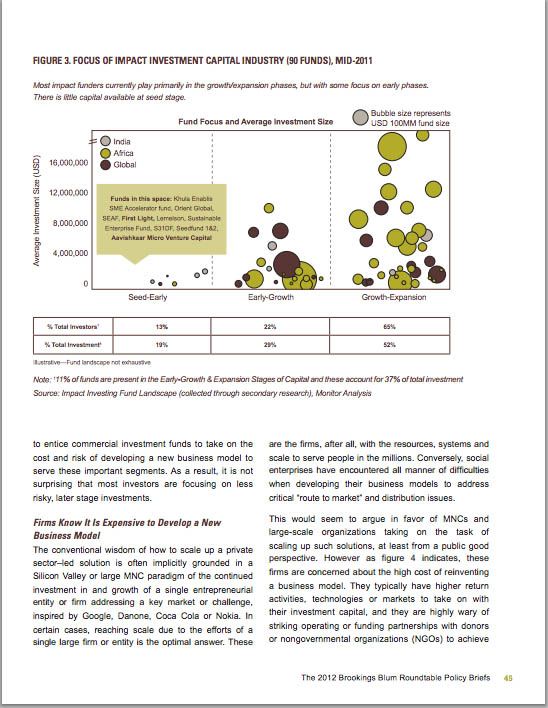Editor's Choice, November 2012: Business models and whether donors 'get' them

How long does it take for an inclusive business model to go to scale? We will all say 'longer than the timeframe donor programmes recognise'. But how refreshing to see graphs that actually plot the answer. Or more precisely, answers. For 'market entry models', where consumers are used to paying for the product, a new entrant can reach scale in 2-5 years. But for 'market creation models' where consumer awareness and demand needs to be built up, it can take a decade or more.
These nuggets lie in the latest output from Monitor. This one is not another flagship report, but a short article The Importance of Business Models written by Mike Kubzansky and published by Brookings. The starting point is familiar: getting the business model right for base of pyramid markets is difficult and necessary, and it is the model that determines success. Not all succeed. But the article moves swiftly on to draw out implications.
Firstly that donors and development actors, increasingly enthusiastic about support for private sector solutions, still don't really get it. They focus on the sector or the technology, and miss the lens which prioritises getting the business model right. And thus expectations are too high and too uniform, and attention is mis-placed. Coming as I do from the Business Innovation Facility, which was set up precisely to help entrepreneurs and intrapreneurs get the business model right, it's not surprising that I agree, and believe there are exceptions to this rule.
The second implication is that it can take decades to hone the business model to the point where it achieves scale. Particularly if it is creating markets, such as for solar lighting or low cost housing, rather than entering existing ones. It took 30 years for microfinance, 50 years for contract farming. This diagram shows where Monitor would place many of the current hot models, in terms of their business maturity.
Thirdly, private sector investment is skewed towards later stages of maturity - so there is ample opportunity for development funds to fill a gap, and support the higher risk early stages. This certainly tallies with what we hear from applicants to Innovations Against Poverty: they are aiming to test and prove their business model. IAP funds are critical because others will only come in once that stage is complete.
Fourthly firms are wary of the costs and risks of kicking off business model development. They may opt for the easier and more mature models, higher income markets, particularly if they are large corporates. Here Mike challenges some of the orthodoxy I sometimes hear, at least on this side of the pond: that multinationals are the easiest way to achieve scale at the BOP. He points out that they are not likely to be those that take the highest risk and hardest challenge.
But the conclusion is very positive: donors could do more to support refinement and uptake of successful business models. They should support early stage innovation, fund research that tackles cross-cutting challenges, (e.g. payment, customer education, supplier training); focus on stages of maturity to help the transition away from donor support or into scale; and support exchange of data and knowledge about business models. Agreed.
Note
An extended elucidation of the same thesis, titled “Why Business Models Matter,” is available in the forthcoming volume Getting to Scale: How to Transform the Lives of Millions of the World’s Poorest People, published by Brookings Institution Press.
Editor's Choice archive lists each monthly choice since December 2010